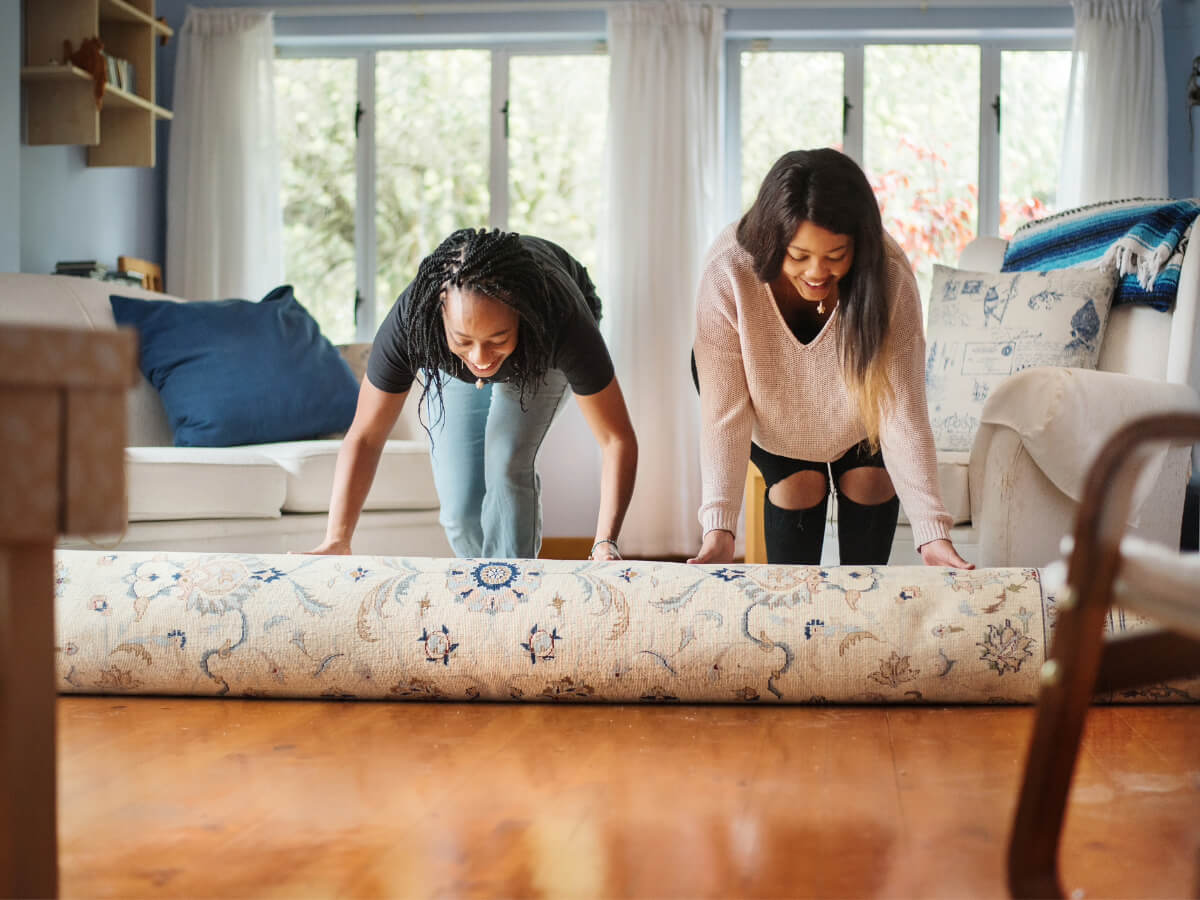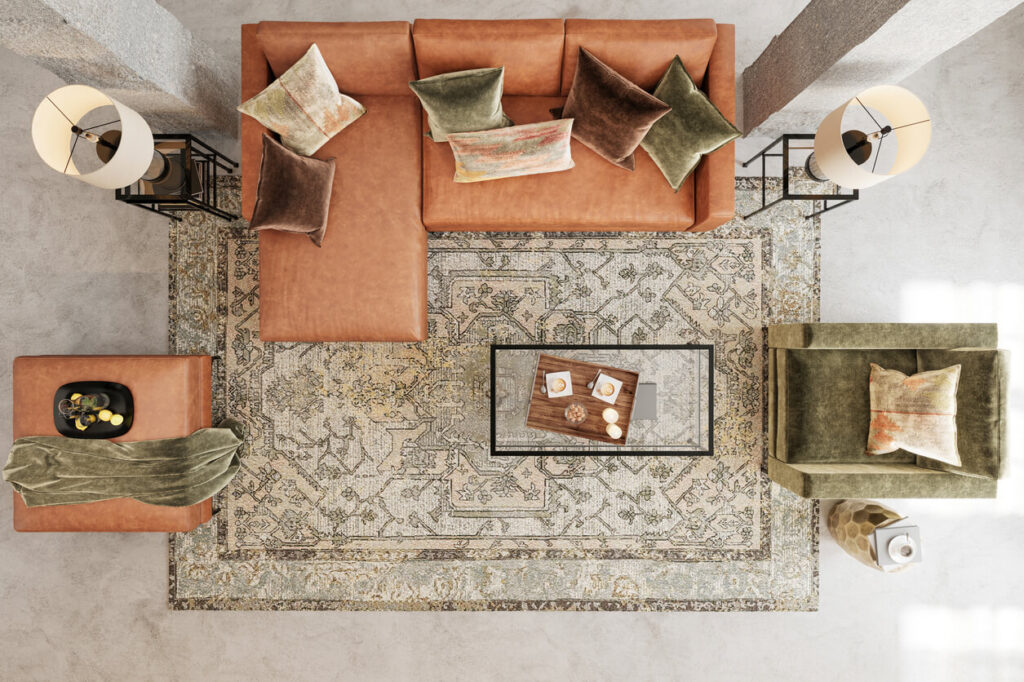
The Ultimate Living Room Rug Placement Guide
 One element that can truly tie a living room together is a well-placed rug. A carefully selected rug not only adds warmth and texture but also defines the space and sets the tone for your entire decor. However, knowing how to arrange a rug in a living room is a skill all of its own.
One element that can truly tie a living room together is a well-placed rug. A carefully selected rug not only adds warmth and texture but also defines the space and sets the tone for your entire decor. However, knowing how to arrange a rug in a living room is a skill all of its own.
In this guide, we’ll dive into the fundamentals of living room rug placement as well as creative tips for under-couch positioning.
Living Room Rug Placement Basics
From selecting the appropriate rug size and shape to choosing between different materials, each factor plays a crucial role in achieving a harmonious and visually appealing space. We recommend determining the size, shape, and material of your rug before moving on to more stylistic aspects, like color schemes. Here are some tips to consider.
Rug Size
Rug size plays a big role in living room design, and striking the right balance between the rug’s dimensions and the room’s layout is essential. A too-small rug can disrupt the flow of your space, while an overly large option may overshadow the furniture and overall arrangement.
Before making a rug purchase, consider implementing these tips.
- Measure the space: Measure your living room carefully to determine the ideal rug size for your space. This will help you avoid a purchase that’s too small or too large.
- Ensure proper proportions: Ensure that the rug is proportional to the space. Large rooms typically require larger rugs, while a longer room may demand a lengthier rug.
- Do a trial run with painter’s tape: Mockup where your rug will go using painter’s tape. This is a great way to perform a test run on the placement, spacing, and size of the rug.
- Plan for any obstructions: Ensure that the rug placement allows for easy movement throughout the living room. Avoid placing the rug where it obstructs doorways or creates tripping hazards.
Rug Shape
Rug shape is an often underestimated aspect of rug placement. The choice between round, square, or rectangular options can affect the room’s atmosphere. Here are some factors to consider when choosing a specific rug shape.
- Rectangular rugs: Rectangular rugs are classic, versatile, and often align well with the edge lines of furniture, especially in rooms with a more formal layout.
- Round rugs: Round rugs can introduce an element of contrast and soften sharp angles of furniture arrangements. They’re also great for adding a touch of whimsy to the space.
- Square rugs: Square rugs are often more practical since they help to define a square or symmetrical living space.
Rug Material
Is there heavy foot traffic in your living room? Do you have children or pets? Or maybe you’re looking for a stylistic option for your low-traffic space. Consider both the functionality and aesthetics of your living room before choosing rug material or fabric.
- Function: When it comes to function, wool rugs offer plushness, durability, and are naturally stain-resistant. But if you want something more affordable, consider synthetic fibers like nylon or polyester since they can withstand heavy use and are easy to clean.
- Aesthetics: If you’re approaching your new rug purchase with style in mind, plush and shaggy rugs offer a sense of warmth and comfort, making them ideal for cozy, intimate settings. Flatweave rugs, on the other hand, exude a sleek and sophisticated look that complements modern and minimalist designs.
- Sustainability: Prefer a rug option that meets your eco-conscious preferences? Natural fibers like jute or bamboo offer a sustainable alternative while providing a sleek overall design.
Rug Color and Pattern
There’s no better time to enhance your room’s color scheme than when purchasing a new rug. A neutral rug can serve as a serene backdrop for vibrant furniture and decor, while a boldly patterned or colored rug can infuse energy into a more monochrome environment. The key lies in identifying a color palette that complements and elevates your design style.
Rug Under Couch Placement Tips
When learning how to arrange a rug in a living room, it’s important to remember that different types of furniture and arrangements demand different approaches to rug placement. A living room with a sectional sofa might require a generously sized rug, while a loveseat and sofa combination will likely require more balancing effort.
When it comes to your living room furniture and rug placement, here’s how to get started.
1. Avoid wall-to-wall placement. 
Leave at least a foot of space between the rug and walls so that the rug stands out against the flooring. Doing so helps to anchor your living room’s arrangement, preventing the look of wall-to-wall carpeting.
2. Consider popular layouts.
Many popular layouts ensure that the rug either extends beyond the backend of major furniture pieces or encompasses all of the frontends of those same furniture items. Avoid disconnecting the rug from the furniture in the space.
3. Try the floating rug method.
In some cases, you might have a sectional that doesn’t rest against any walls. In such situations, consider a floating rug placement. Center the rug beneath the sectional, leaving equal space on all sides. This technique adds symmetry and balance to the room, making it feel well put together.
4. Use multiple rugs.
If you’re trying to identify the perfect rug size for a living room with a sectional and additional seating pieces, consider using multiple rugs to define distinct areas. Place an area rug under the main seating section, and use smaller rugs for the chaise lounge or additional seating pieces. This creates a harmonious flow while allowing you to customize each zone with different textures or patterns.
5. Consider layering your rugs.
For a visually interesting and eclectic feel, experiment with layering rugs. Place a larger, neutral-colored rug as the base, and then layer a smaller, patterned, or textured rug on top. This approach works well if you have a loveseat and sofa that are slightly apart from each other.
6. Implement a centered rug.
If you have a loveseat and sofa placed together against a wall or a large window, a centered rug works wonders. Align the rug with the midpoint of the furniture, ensuring both the loveseat and sofa rest fully on the rug.
Shop Rugs, Furniture, and More at Rent-A-Center
Finding the right rug size and placement can make a remarkable difference in your living room’s overall look and feel. By aligning your choices with the room’s layout, furniture types, color scheme, and overall design intent, you can transform your living room into a haven of aesthetic beauty.
With Rent-A-Center’s collection of rugs and living room furniture sets, you can create a stunning space that reflects your style and offers exceptional comfort. Shop online or stop by your nearest Rent-A-Center location today.